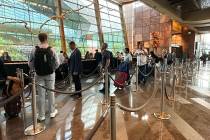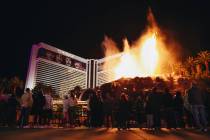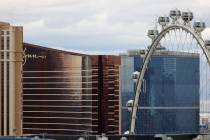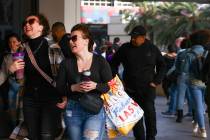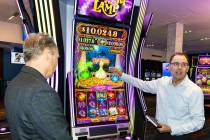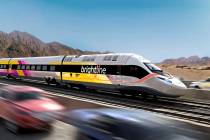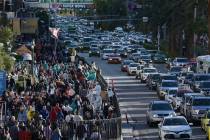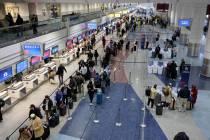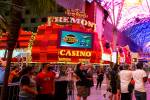2045 eclipse should be big for Nevada’s tourism industry
To the parents and grandparents who took the time to share the science of last week’s Great American Eclipse to children and grandchildren, I salute you.
You might have planted a seed of curiosity that one day might play an important role in our tourism economy.
The youngsters of today will be in their 30s and 40s in 2045, the year Great American Eclipse III darkens the skies over Northern Nevada in what could be one of the greatest tourism events in our state’s history.
There were some high points and low points in Monday’s total eclipse, which dazzled thousands of people in several locations, including Wyoming, a state that, like Nevada, has hundreds of miles of two-lane roads and few major population centers.
When the moon’s shadow passes between the sun and the Earth on Aug. 12, 2045 — a Saturday — it will cover most of the northern half of the state, including the entire length of Interstate 80 within Nevada’s boundaries.
The alignment of the sun, moon and Earth in that eclipse will make totality longer than the one experienced Monday. In some locations along the path, the skies will darken for four minutes, almost twice as long as the Monday event.
A piece of trivia: Reno will be in the path of totality, but Carson City won’t; there’s probably a political joke or two hidden within that factoid.
It's like sunset in every direction during #SolarEclispe2017. Several got air balloons in the air Glendo State Park. pic.twitter.com/otbX7WEGrg
— Rick Velotta (@RickVelotta) August 21, 2017
Wyoming clearly wasn’t ready for the population onslaught that accompanied Monday’s big event. But who could be ready for something that more than doubles a state’s population for a day and brings more cars into the state in one weekend than are registered by residents statewide?
Highways across the state were jammed. My return to Denver from Glendo, Wyoming, a distance of about 200 miles that normally takes 2½ hours, took about 16 after the eclipse.
State police and sheriff’s department officers directed people leaving Glendo State Park, a perfect viewing location for the eclipse, away from Interstate 25 even before the eclipse was over. No one explained why, and motorists chatting with each other as they waited out the traffic were frustrated.
Thousands have descended on Glendo, population 205 for #SolarEclipse2017 Officials said population of Wyoming would double today. pic.twitter.com/ludxkiC8nh
— Rick Velotta (@RickVelotta) August 21, 2017
Once on I-25, the main traffic artery between Cheyenne and Casper, the state’s two largest population centers, and Denver, vehicles were gridlocked.
When traffic did move, it was at about 25 mph, tops. Once in a while, traffic would disperse, and vehicles could get up to maybe 50 mph before it would all bog down again for no apparent reason.
The traffic jam after #SolarEclipse2017. pic.twitter.com/2PyDO9bPdn
— Rick Velotta (@RickVelotta) August 21, 2017
Before the eclipse, Wyoming officials made a good effort marketing the state’s tourism attractions, hoping visitors would see Yellowstone and Grand Teton national parks and Jackson Hole in addition to other lesser-known sites while around for the big event.
Now, substitute Nevada for Wyoming. State leaders no doubt will need to promote what Nevada’s northern rural communities have to offer before the big event. Visitors will need to get the same education Wyoming offered to umbraphiles arriving in its state: “Communities — and gasoline for your car — are far apart.” The desert in August can be unforgiving, so take plenty of food and water, especially because you’re bound to be in your car far longer than you thought because of traffic gridlock.
Several gasoline stations were limiting fuel sales to tourists to accommodate their resident clientele.
Generally, Nevada does a great job of accommodating big crowds for special events. A superfight like McGregor-Mayweather? No problem. The Super Bowl or the World Cup, once the new stadium is built? Piece of cake. The Winter Olympic Games in the Lake Tahoe area someday? We can figure it out.
But those big events are far different than an eclipse. A big fight or a Super Bowl caters to well-moneyed individuals buying tickets and checking into luxury hotel rooms.
Eclipses are events for everybody because you don’t need to buy a ticket. Just look up with your $2 special glasses, wait for totality and become enveloped by the cosmic coincidences that nature has provided. Camp out and bring a tent. It’s a cheap outdoor adventure.
In 2045, they will come in droves from the big population centers that aren’t in the path of totality: San Francisco. Sacramento. Boise. And Las Vegas.
Besides the hundreds of astronomical society members and science geeks that showed up at Glendo State Park in central Wyoming, there were thousands of children brought by parents or friends. They’re all going to remember how much fun they had the day the sun disappeared for a couple of minutes in the middle of the day.
This isn’t a call to action, by the way. We have 28 years to get ready for the event, and there’s another major American eclipse in between, coming April 8, 2024, extending from Texas to Maine.
Nevada’s current leaders and policymakers will be long gone or retired by the time the Nevada eclipse occurs. But the next generation of leaders — you know, the little kids who watched the eclipse in wonderment on Monday — will be the ones calling the shots.
They’re the ones who are going to have to worry about whether Nevada has enough charging stations to accommodate the thousands of electric cars that will be on the road by that time and whether to allow people to camp out for free on public land across the totality zone.
I hope I’m around for the 2045 eclipse. It’ll be exciting to see Northern Nevada’s moment in the sun — or lack of it.
Trust me, if it’s anything like Monday, it’ll be a great show.
Contact Richard N. Velotta at rvelotta@reviewjournal.com or 702-477-3893. Follow @RickVelotta on Twitter.

















